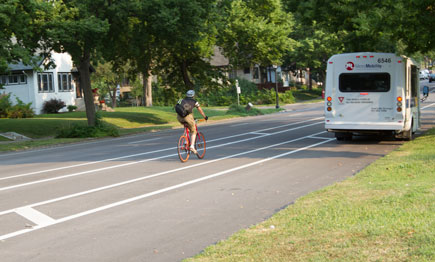Cities promote strong bicycle networks to support and encourage bicycle commuting, yet until now little has been known about how the overall quality of a city’s bicycle infrastructure network impacts bicycle ridership.
In a study analyzing bike networks in 74 U.S. cities, University of Minnesota researchers have discovered that even after controlling for city size and demographics, both connectivity and directness are important factors in predicting bicycle commuting.
“This new research fills in a big gap in our knowledge about how bike facilities impact ridership,” says Jessica Schoner, research assistant in the Department of Civil, Environmental, and Geo- Engineering (CEGE) and lead author of the study. “Previous studies have found relationships between the quantity of bicycle infrastructure in a city and ridership, but the missing link has been insight into how the quality of a network affects bike ridership.”
To determine how network quality affects ridership, Schoner and co-author RP Braun/CTS Chair David Levinson began by collecting bicycle infrastructure maps from 74 mid- to large-sized U.S. cities and analyzing the maps to evaluate the backbone network of dedicated bicycling infrastructure. Then, they tested the relationship between the network analysis and the number of bicycle commuters in the city while controlling for a number of variables, including city population, land area, median income, household structure, college enrollment, and auto ownership.
“We wanted to determine whether a cyclist could complete their desired trip using the bicycle network without significant detours or gaps that would require riding in unsafe or uncomfortable conditions,” Schoner says.
Through their analysis, researchers found that a city’s bicycle commuting rate is associated with several measures of bike network quality, such as network density, connectivity, fragmentation, and directness. Interestingly, they discovered that density had the greatest impact on the level of bicycle commuting. According to Schoner, these findings suggest that cities hoping to maximize the impacts of their bike infrastructure investments should first consider increasing the density of a bike network before expanding its breadth. Researchers also concluded that excessive small fragments of bike facilities should be avoided, and they found that college enrollment is a strong predictor for bicycle commuting.
This research comes at a critical time in the development of bicycle networks across the U.S. According to the Federal Highway Administration (FHWA), cities are increasingly promoting biking for its environmental, health, and congestion-relief benefits. Investment in bike facilities has also increased: between 1999 and 2011, total federal and state government funding on bicycling and pedestrian infrastructure exceeded $7 billion. In 2012, the FHWA completed the Nonmotorized Transportation Pilot Program, which allocated $25 million each to four pilot cities over five years to measure the impacts of new infrastructure on mode shift to biking and walking.
“As we continue to invest in our country’s bike networks, it is important for transportation and planning agencies to fully understand how their bicycle infrastructure networks affect bicycle commuting in order to target investments in a way that optimizes the impact on existing riders and potential future cyclists,” says Schoner. “These findings provide a framework for transportation planners and policymakers to evaluate their local bicycle networks and prioritize the projects that best support nonmotorized travel behavior.”




